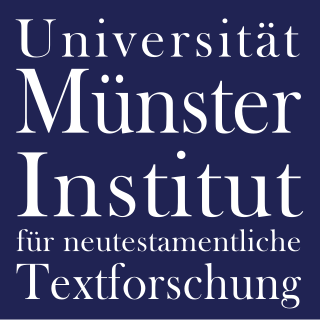History
Scrivener and Gregory dated the manuscript to the 12th century. [3] [4] It has been assigned by the Institute for New Testament Textual Research to the 12th century. [1] [2]

The Institute for New Testament Textual Research at the University of Münster, Westphalia, Germany, is to research the textual history of the New Testament and to reconstruct its Greek initial text on the basis of the entire manuscript tradition, the early translations and patristic citations; furthermore the preparation of an Editio Critica Maior based on the entire tradition of the New Testament in Greek manuscripts, early versions and New Testament quotations in ancient Christian literature. Under Kurt Aland's supervision, the INTF collected almost the entire material that was needed - Manuscript count 1950: 4250; 1983: 5460; 2017: approx. 5800.
The manuscript was added to the list of New Testament manuscripts by Scrivener (number 164e and 165e) and Gregory (number 285e). Gregory saw the manuscript in 1886. [4] According to Scrivener the first leaf belonged to the other manuscript. [3] It was not confirmed by Gregory, Aland and other textual critics. [2]
The manuscript is not cited in the critical editions of the Greek New Testament (UBS3). [5]
The codex is housed at the Biblioteca Ambrosiana (I. 94 suss., fol. 1-37) in Milan. [1] [2]
This page is based on this
Wikipedia article Text is available under the
CC BY-SA 4.0 license; additional terms may apply.
Images, videos and audio are available under their respective licenses.
Lectionary 283, designated by siglum ℓ 283 is a Greek manuscript of the New Testament, on parchment. Palaeographically it has been assigned to the 11th century.
Scrivener labelled it as 162e.
Lectionary 280, designated by siglum ℓ 280 is a Greek manuscript of the New Testament, on parchment. Palaeographically it has been assigned to the 14th century.
Scrivener labelled it as 185e.
Lectionary 281, designated by siglum ℓ 281 is a Greek manuscript of the New Testament, on parchment. Palaeographically it has been assigned to the 14th century.
Scrivener labelled it as 160e.
Lectionary 282, designated by siglum ℓ 282 is a Greek manuscript of the New Testament, on parchment. Palaeographically it has been assigned to the 14th century.
Scrivener labelled it as 161e.
Lectionary 284, designated by siglum ℓ 284 is a Greek manuscript of the New Testament, on parchment. Palaeographically it has been assigned to the 10th century.
Scrivener labelled it as 163e.
Lectionary 286, designated by siglum ℓ 286 is a Greek manuscript of the New Testament, on parchment. Palaeographically it has been assigned to the 9th century.
Scrivener labelled it as 480e.
Lectionary 287, designated by siglum ℓ 287 is a Greek manuscript of the New Testament, on parchment. Palaeographically it has been assigned to the 13th century.
Frederick Henry Ambrose Scrivener labelled it as 166e.
Lectionary 288, designated by siglum ℓ 288 is a Greek manuscript of the New Testament, on parchment. Palaeographically it has been assigned to the 13th century.
Scrivener labelled it as 167e.
Codex Tischendorfianus V or Lectionary 293 (Gregory-Aland), designated by siglum ℓ 293 is a Greek manuscript of the New Testament, on parchment. Palaeographically it has been assigned to the 8th century.
Scrivener labelled it as 190e.
Lectionary 301 (Gregory-Aland), designated by siglum ℓ 301 is a Greek manuscript of the New Testament, on parchment. Palaeographically it has been assigned to the 13th century. The manuscript is lacunose.
Lectionary 304 (Gregory-Aland), designated by siglum ℓ 304 is a Greek manuscript of the New Testament, on paper. Palaeographically it has been assigned to the 14th century. The manuscript is lacunose.
Lectionary 305 (Gregory-Aland), designated by siglum ℓ 305 is a Greek manuscript of the New Testament, on parchment. Palaeographically it has been assigned to the 12th century. The manuscript is lacunose.
Lectionary 306 (Gregory-Aland), designated by siglum ℓ 306 is a Greek manuscript of the New Testament, on parchment. Palaeographically it has been assigned to the 13th century. The manuscript is lacunose.
Lectionary 307 (Gregory-Aland), designated by siglum ℓ 307 is a Greek manuscript of the New Testament, on parchment. Palaeographically it has been assigned to the 12th century. The manuscript is lacunose.
Lectionary 308 (Gregory-Aland), designated by siglum ℓ 308 is a Greek manuscript of the New Testament, on parchment. Palaeographically it has been assigned to the 11th century. The manuscript is lacunose.
Lectionary 309 (Gregory-Aland), designated by siglum ℓ 309 is a Greek manuscript of the New Testament, on parchment. Palaeographically it has been assigned to the 10th century. The manuscript is lacunose.
Lectionary 325 (Gregory-Aland), designated by siglum ℓ 325 is a Greek manuscript of the New Testament, on parchment. Palaeographically it has been assigned to the 13th century. The manuscript has not survived in complete condition.
Lectionary 335 (Gregory-Aland), designated by siglum ℓ 335 is a Greek manuscript of the New Testament, on parchment. Palaeographically it has been assigned to the 11th-century. The manuscript has survived in complete condition.
Lectionary 336 (Gregory-Aland), designated by siglum ℓ 336 is a Greek manuscript of the New Testament, on parchment. Palaeographically it has been assigned to the 14th century. The manuscript has not survived in complete condition.
Lectionary 337 (Gregory-Aland), designated by siglum ℓ 337 is a Greek manuscript of the New Testament, on parchment. Palaeographically it has been assigned to the 12th-century. The manuscript has not survived in complete condition.



